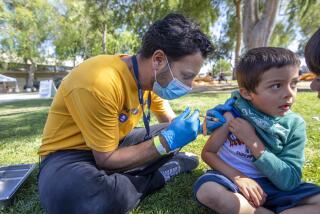Cancer Study Shows Incidence Highest in South County Area
- Share via
Cancer rates in 1984 were higher in Mission Viejo, Dana Point, Laguna Niguel, Costa Mesa, Tustin, Newport Beach and Placentia than in other Orange County communities, according to first-year findings of a precedent-setting cancer study released Tuesday.
Researchers, who said they couldn’t explain the patterns without more data, also said that while cancers of the digestive system, lung and breast were the most common throughout the county in 1984, a higher-than-normal incidence of malignant melanoma--a severe form of skin cancer--was detected, particularly along the coast.
In some beach communities, the researchers found, malignant melanoma rates were many times higher than the national average.
5,979 Cases Charted
The Cancer Surveillance Program of Orange County charted 5,979 cases by age, sex, ethnic group, community and type of cancer, and it will serve as a prototype for a statewide tumor registry in the next few years.
The first-year data from Orange County raises more questions than it provides answers, said program director Hoda Anton-Guirgis, vice chair of UC Irvine’s department of community and environmental medicine.
“At this point, all we have is one mark on the curve. We have to look at the next year and the next year” before drawing conclusions, Anton-Guirgis said. “This is only one year of data.” It will take several years of data to determine whether certain communities, in fact, have higher cancer rates, or whether 1984 was a statistical quirk, she said.
Compliance Rate
But as more information is learned, it will become invaluable in helping the researchers look for causes of cancer, monitor the effectiveness of cancer treatments and target prevention programs, “so you can measure success,” Anton-Guirgis said. Until now, she said, researchers had to base their analyses on mortality studies--that is, cancer deaths.
Under the program, all doctors’ offices, clinics and hospitals have been required to report new diagnoses of cancer. Anton-Guirgis said there has been total compliance.
According to the data, Orange County’s overall cancer rate was 315 per 100,000 people, slightly lower than the national rate of 331.5. The numbers were “age-adjusted”; that is, because older people are more likely to get cancer, the statistics are adjusted to account for varying ages in the communities’ populations.
Among the findings:
- Overall, Dana Point had the highest cancer rate, 447 cases per 100,000 population, followed by Mission Viejo, 442, and Laguna Niguel, 413. The lowest rates in the county were Stanton, 218, the Los Alamitos area, 236, and La Habra, 253.
- The most common cancer in the county in 1984 was cancer of the digestive system, predominantly colon-rectum, with 1,173 cases diagnosed. Breast cancer was the second most common with a rate of 966; followed by respiratory system, 928; female genital, 801; male genital, 524; and urinary tract, 393.
- Malignant melanoma, a severe form of skin cancer, occurred at a rate of nine cases per 100,000 throughout Orange County, compared to the national average of six. The figure was highest along the coast, where the sun worshipers converge. The highest rates were in Laguna Beach, 41 per 100,000; Laguna Niguel, 25; Laguna Hills, 21; San Juan Capistrano, 19; El Toro, 15; Tustin, 15; Newport Beach, 14; and Orange, 14. Cancer researchers have established a link between skin cancer and excessive exposure to the sun.
- By ethnic group, whites incurred 326.1 cases per 100,000. Latinos were diagnosed at 278.7 cases per 100,000; blacks, 470.1 (based on a total of 44 cases) and other ethnic groups (primarily Asian nationalities, but too few to categorize individually), 202.7. Digestive system cancers--which have been linked to high-fat, low-fiber diets--were highest among whites and Latinos, with rates of 65.4 and 67.2, respectively, per 100,000, while among the predominantly Asian group, the rate was 40.7. No rates were given for specific cancer types among blacks because the group was too small.
- Cancer of the cervix among Latin women in Orange County remains high, accounting for about 41% of all female genital cancers within their ethnic group, compared to a national rate of 20%, Anton-Guirgis said. A year ago, researchers had speculated the high rate was due to Latinas visiting physicians less regularly for annual Pap smears, which screen for cancer. But Anton-Guirgis said the cancer study team has since concluded the high rate “is not because they don’t go for Pap smears.” In fact, their cervical cancers have been diagnosed at the same stage as most women’s, so they are not seeing their physicians too late, she said. But Anton-Guirgis said researchers cannot yet explain the anomaly. A specific study on the incidence of cervical cancer among Orange County’s Latinas has been proposed, she said.
- The highest incidence of cancer occurred in the oldest age group. People aged 85 and older had a rate of 2,127.1 cancer cases per 100,000, with digestive system cancer the predominant type, at a rate of 611.3. Overall cancer rates for others were: 15.2 for ages 0-4; 9.8 for ages 5-9; 9.7 for ages 10-14, 12.6 for ages 15-19, 35.4 for ages 20-24, 84 for ages 25-29, 99.9 for ages 30-34, 172 for ages 35-44, 322.9 for ages 45-54, 596.5 for ages 55-59, 1,022.1 for ages 60-64, 1,492.5 for ages 65 to 74, and 2,003.3 for ages 75-84.
Anton-Guirgis was unable to explain the geographical difference or why the highest rates were in the south county area.
“It might be a difference of population,” she said. “This is a county that is growing,” and much of the growth has been in the southern section of the county.
Further, wealth and other socioeconomic factors influence cancer incidence, she said. For example, women of middle- and upper-class incomes are likely to visit a doctor more regularly to detect breast lumps. In addition, different classes eat different diets, and the wealthier groups have been known to eat foods higher in fats, she said.
Other factors that can affect cancer risk are occupational differences among the socioeconomic classes and the hazards in the workplace, such as asbestos, said Dr. B. Dwight Culver, co-director of the surveillance program and chairman of the division of occupational medicine in UCI’s department of community and environmental medicine.
“One of the reasons we were eager to establish the program was to study the incidence of cancer and determine what relationship” there is between the disease and the workplace, among other factors, he said.
Anton-Guirgis said researchers need at least one more year’s data before they can begin to draw conclusions, and five years of data would provide even more definite answers. The average survival after a lung cancer diagnosis is less than one year, so a second year’s data for the respiratory disease would yield information about treatment programs, she said. However, researchers usually set five years as a cure rate for most other cancers, she said.
The study was co-sponsored by UCI, the state Department of Health Services, the county Health Care Agency and the Orange County unit of the American Cancer Society.
Anton-Guirgis warned against drawing conclusions from the overall rates. “Cancer is not one disease,” she said. “Each cancer site (type) is an individual disease.”
The researchers presenting the data agreed that lung cancer is the most easily preventable cancer. “Everyone but the American Tobacco Institute acknowledges the link” between smoking and cancer, said Dr. James L. Whittenberger, director of UCI’s occupational health center.
However, it is not known how the lung cancer rates, as mapped by the study, correspond with the county’s smoking habits, said Dr. Tom Prendergast, director of Orange County Health Department’s epidemiology and disease control. That might be an avenue for the county to explore, he said.
ORANGE COUNTY CANCER RATES First-ever statistics mapping cancer rates reveal, community by community, where the disease was diagnosed in 1984, but researchers say more data is needed before they can explain the link between geography and cancer. Following are the cancer rates, per 100,000 population, for Orange County communities.
CANCER COMMUNITY RATE (Per 100,000) Anaheim 313 Brea 318 Buena Park-La Palma 354 Costa Mesa 373 Dana Point 447 El Toro 313 Fountain Valley 298 Garden Grove 341 Huntington Beach 342 Irvine 347 Laguna Beach 331 Laguna Hills 335 Laguna Niguel 413 La Habra 253 Los Alamitos/Seal Beach 236 Mission Viejo 442 Newport Beach 359 Orange/Villa Park 345 Placentia 396 San Clemented 274 San Juan Capistrano 347 Santa Ana 286 Stanton 218 Tustin 368 Westminster 342 Yorba Linda 322 Orange County 315 National Average 332
Source: Cancer Surveillance Program of Orange County
More to Read
Sign up for Essential California
The most important California stories and recommendations in your inbox every morning.
You may occasionally receive promotional content from the Los Angeles Times.













